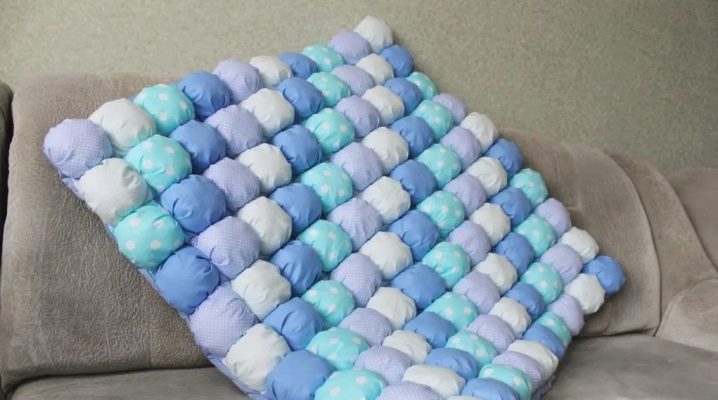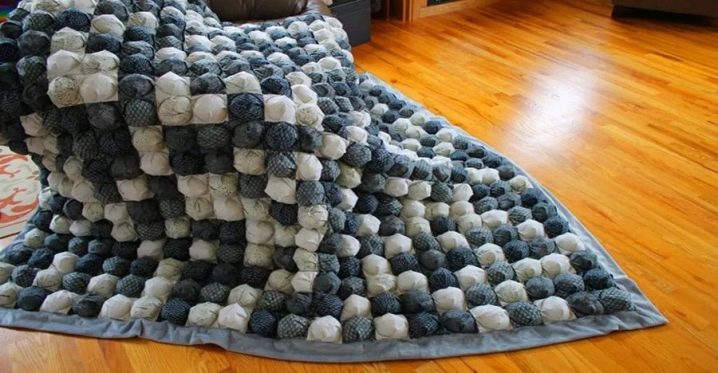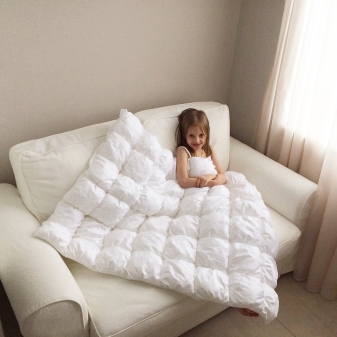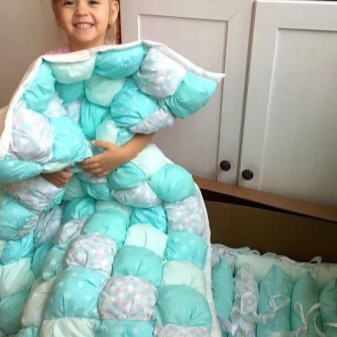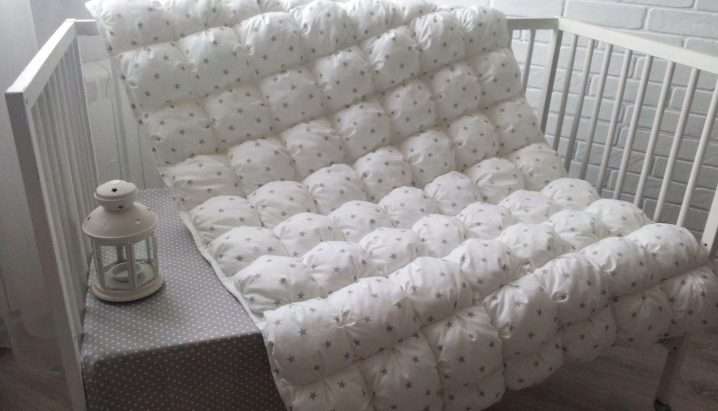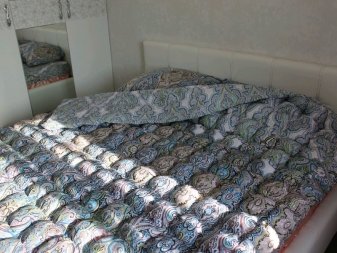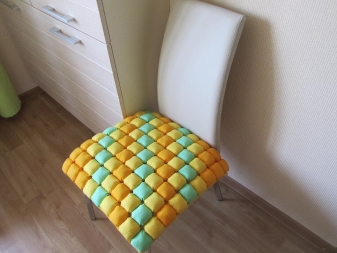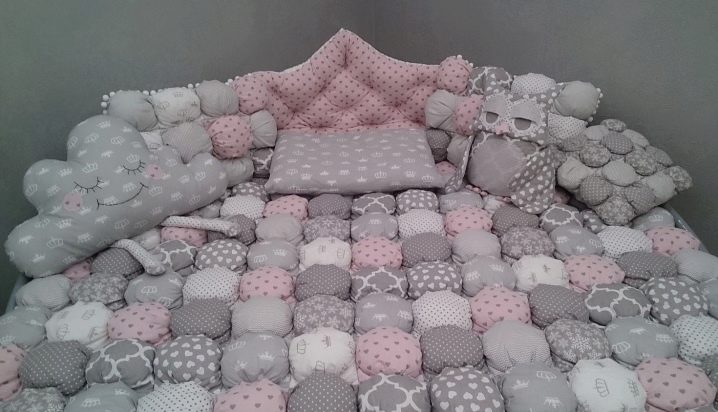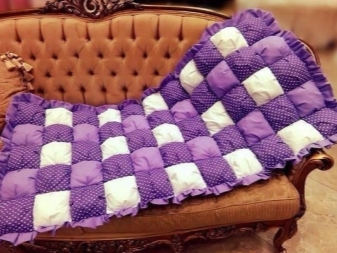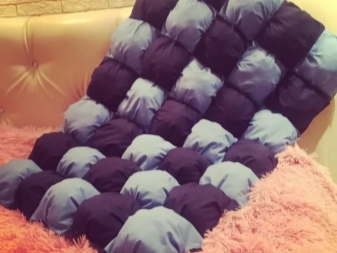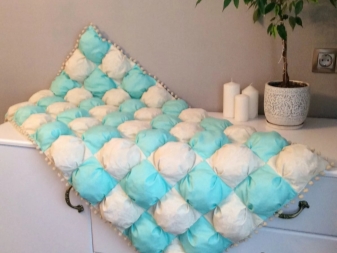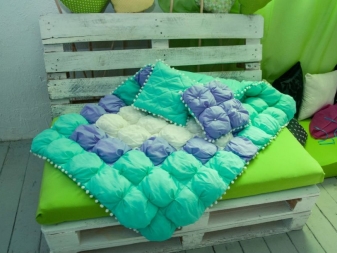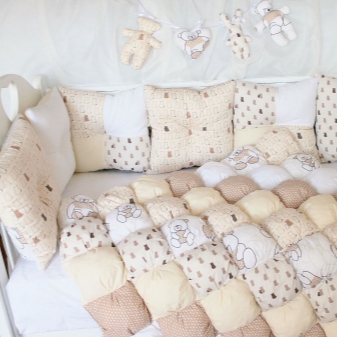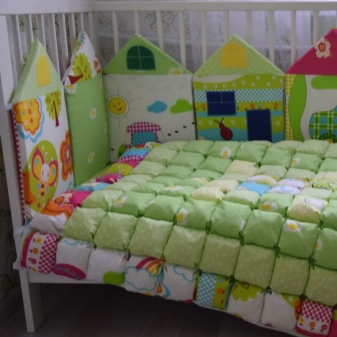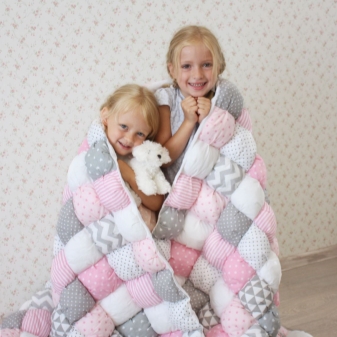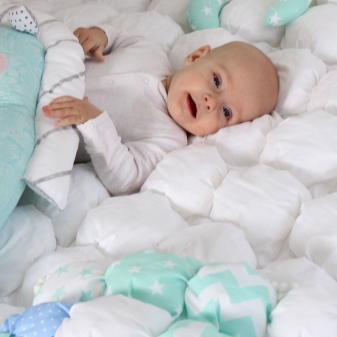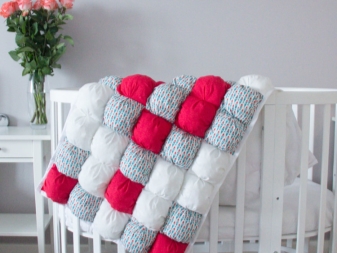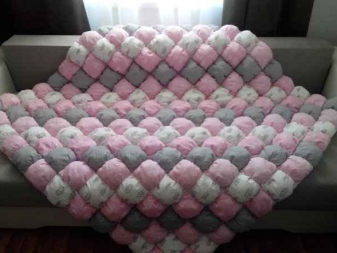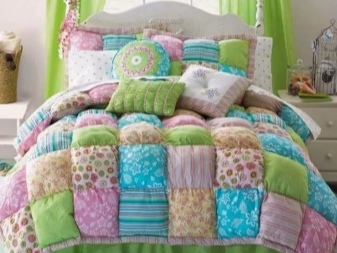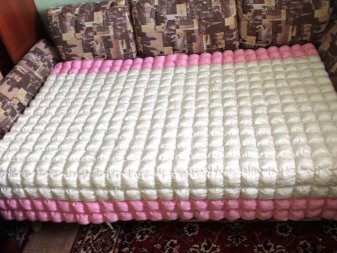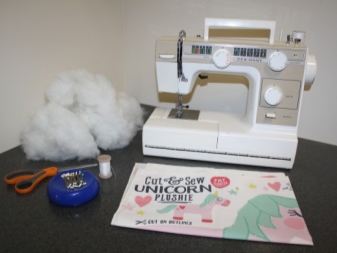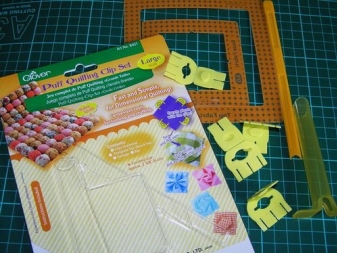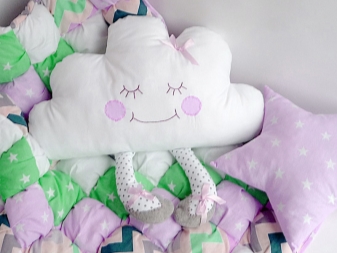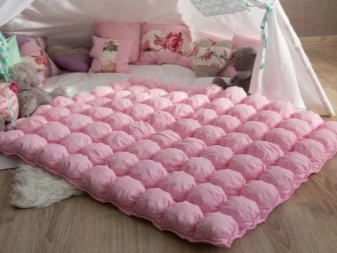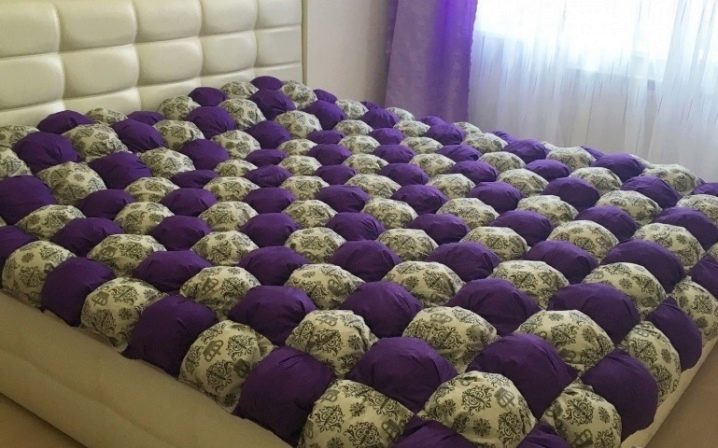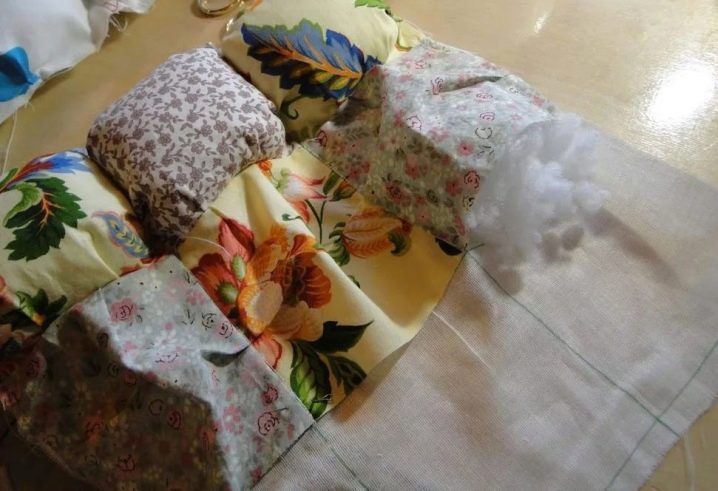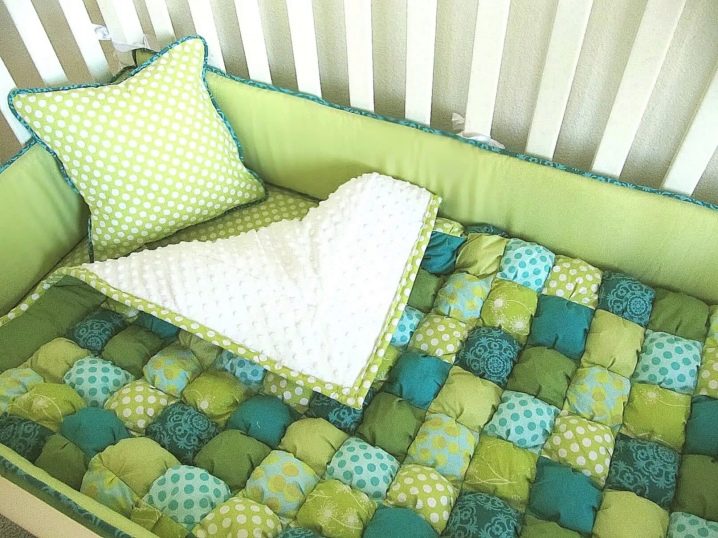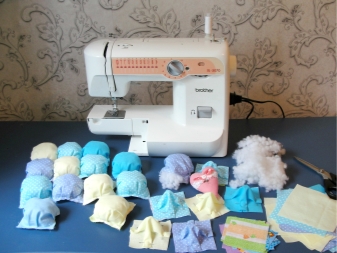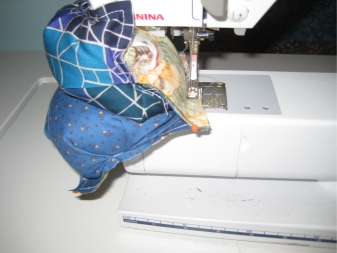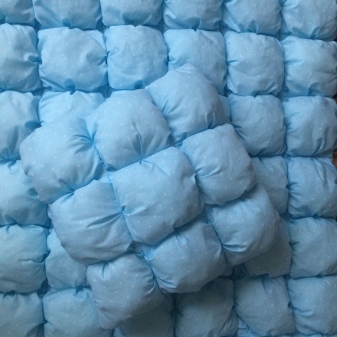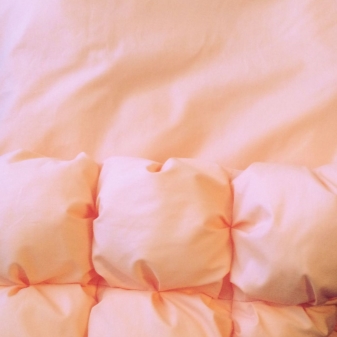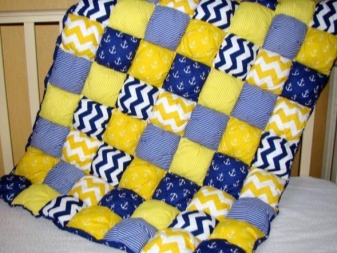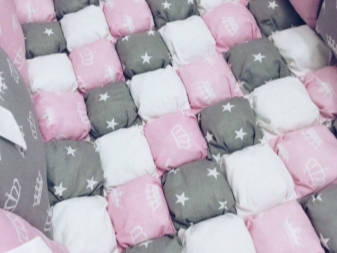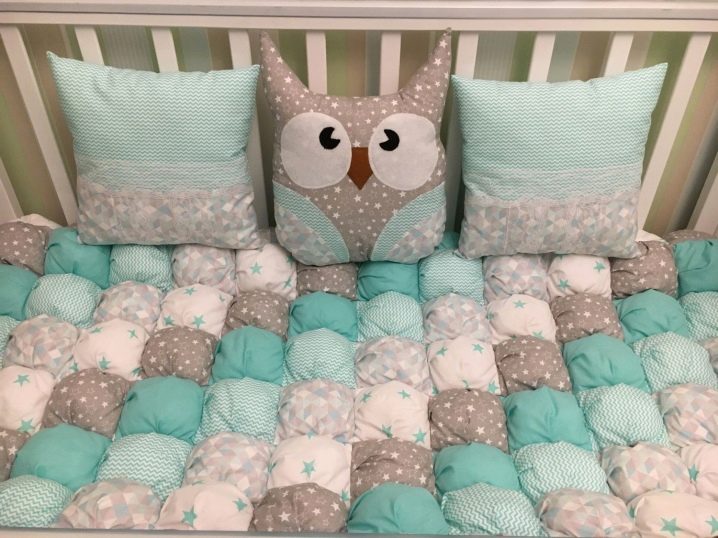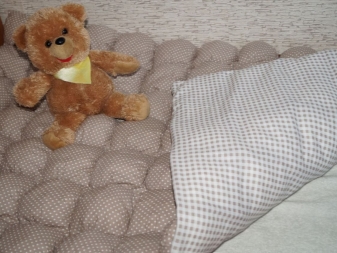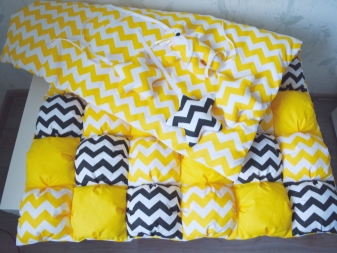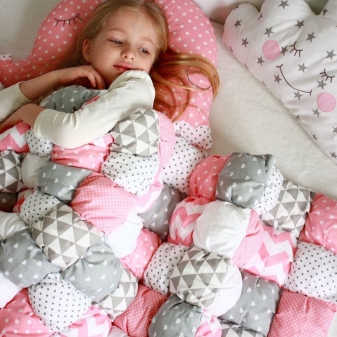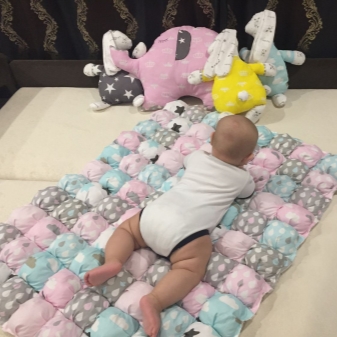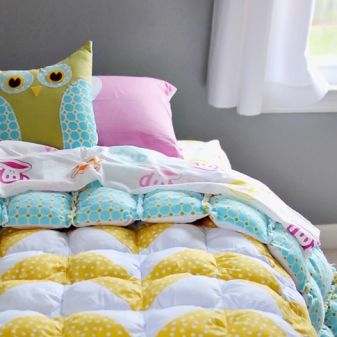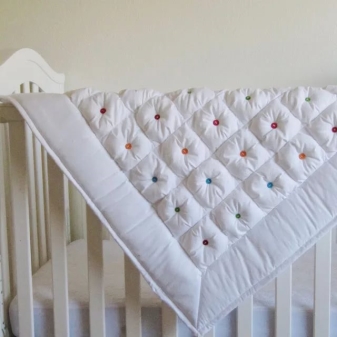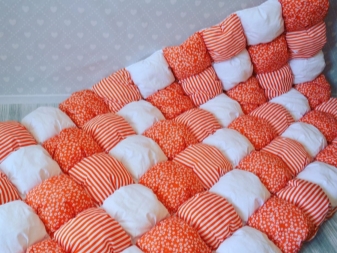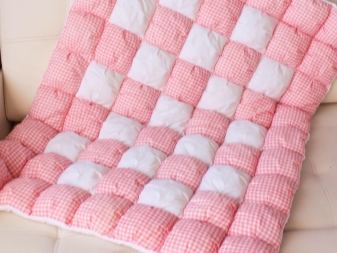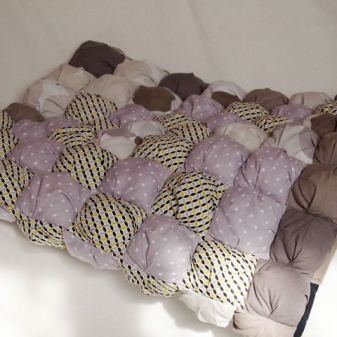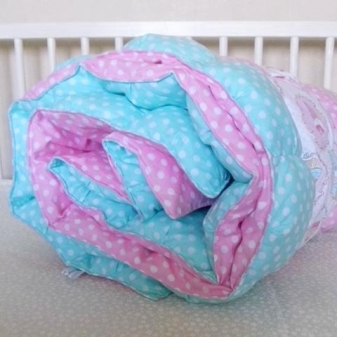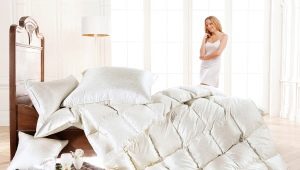Blanket in the technique of "bonbon"
To make a children's room cozy, you definitely need beautiful textiles. The fashionable novelty of the last months - a blanket in the "bonbon" technique - will not leave anyone indifferent. It is so cute that it will appeal to all family members.
What it is?
The blanket “bonbon” (or “bombon” - both names are equally common) is a product made in patchwork technique with stuffing. It consists of many identical squares that are filled with padding polyester, holofiber, or batting. It looks like a canvas, made of many small pillows. Such a blanket looks unusually cute and cozy. Craftswomen throughout the country not only blankets, but also pillows, baby cots, checkout envelopes and other cute little things for babies, using the bonbon technique. Each product is specially selected pattern that makes them unique.
Blanket "bonbon":
- Soft and hypoallegic, because.100% cotton materials are used for its production (not counting stuffing).
- Very warm
- Lung.
- Looks amazingly beautiful in the interior.
Of the shortcomings of this product, it can be noted that it is expensive (it is made exclusively by hand and the process is not too complicated, but requires accuracy and painstakingness). The average size of a baby blanket will cost about 5,000 rubles. It is also whimsical in the care - it must be washed with delicate means, dried in the straightened form, straightening each pad with his hands so that it does not pile. Just ironing him with an iron will not succeed either - you will have to use the “steam blow” technique or walk carefully with a steamer.
Dressed "bonbon" will be a great gift for children and adults. It is also perfect for “adult” interiors, especially for bedrooms in the classic (but not too pompous) or Scandinavian styles.
In this technique, you can also make textiles for the kitchen - for example, decorative pot holders or pillows for stools and chairs.
Origin
The “bonbon” technique (also called “biscuit”) is one of the patchwork technique techniques — patchwork.Clothes and household items, sewn from various patches, existed in many nations of the world since antiquity, since fabrics have always been in short supply and it was not advisable to throw away trimming. Patchwork as a direction in decorative and applied art developed most of all in England and America, where bright and beautiful fabrics from the colonial states arrived. The patchwork technique was also in Russia (it suffices to recall the blankets and bedspreads of our grandmothers and great-grandmothers!).
Technique "bonbon", in comparison with other options for the manufacture of patchwork products is actually very simple. In this case, the product looks incredibly impressive.
Many mothers who are on maternity leave with children are trying to start their own business. This is how workshops are made, where they take orders for the production of designer textiles for children. Unique bumpers on the bed, pillows, letters, cocoons for sleeping, bed linen, envelopes for discharge - all this is extremely popular today to order. It is in such workshops that the “bonbon” blankets are made according to the design of customers in unique color and style solutions.
What is it for?
By appointment, the “bonbon” blanket is more decorative than functional.Of course, it is possible to hide them, but still it is a pity, because it can be crushed and lose an attractive appearance. Therefore, the main purpose of such a product is a blanket.
A set of “biscuit” textiles will look very nice - a bedspread and pillows or a bedspread and soft sides in the crib.
You can use the "bonbon" as a blanket, if the child is still quite small, about a year. Kids, even if they are very mobile in their sleep, will not do much harm to the blanket.
Girls such a blanket can serve for years, until students and more. Women at any age will most likely enjoy a luxuriant and delicate product. Boys blanket "bonbon", most likely, will be suitable to primary school age. Then the cover will have to change to a more solid.
Adults can use it as a blanket during pleasant gatherings at the TV or with friends. It can serve as a bedspread in the bedroom or be part of the decor of the living room, decorated in light, "marshmallow" colors.
How to do?
There are several ways to make such a blanket. All you need is basic skills in a sewing machine.However, this will be a very painstaking exercise that requires precision. Make a beautiful "bonbon" in a hurry will not work.
To make a blanket, you will need:
- cuts of bright fabrics for "pads";
- stuffing (synthetic winterizer, sintepukh, hollofayber);
- fabric for the base (the one that goes to bedding, ideally - thick coarse calico);
- fabric for the back side (it can be a knitted fabric that is pleasant to the body, but you should be able to work with it. Beginners should restrict themselves to ordinary cotton fabric);
- edge decor - satin ribbon, rep ribbon, oblique knit tape;
- threads;
- tools and equipment: sewing machine, iron, paper, pencil, ruler, tailor's chalk, scissors, tailor's pins.
The fabric for pillows is selected based on the desired pattern. It is necessary to draw a draft of the future blanket on a sheet of paper in advance, where to break it into squares and draw each one with the color or pattern that will be on the blanket. So you get a pattern for sewing. Sewing in patchwork technology always begins with a pattern.
In theory, the “bonbon” blanket can be monotonous or you can collect pads in random order. But a beautiful pattern that is easy to lay out like a mosaic will look much better.
The fabric for the base on which the pads will be sewn can be of any color - no one will see it. You can use your existing sheet or duvet cover.
The material for the reverse side is the reverse side of the product. It should be beautiful and be combined in color with a blanket or successfully contrasted. Very often, this lining material is used as a piping for processing the edge, it looks very aesthetic.
Decide on the size of the future product. Measure the length and width of the bed. The standard size of the “pads” in finished form is 11 by 11 cm. Calculate how many pads you will need for your size of blanket.
Then you need to take the fabric-based and draw it so that at the edges of the blanket there are 3-5 centimeters of allowance from all sides. Then the basis is completely lined up on squares with a side of 11 cm. An important detail: after the first row of squares is drawn, it is necessary to make an allowance for sewing on the next row. That is, draw a line horizontally 1 cm below, and draw the next row from it. Further actions are repeated until the very end.
If the finished “cushion” is 11 by 11 cm, then the size of the squares when cutting will be 17 by 17 cm. They will take into account seam allowances on all sides and future folds.
Very important: before beginning to cut, all fabrics should be washed and carefully ironed. Iron - one of the main tools in patchwork: without a well-ironed parts and seams beautiful product will not work.
Next, the technology is as follows:
- After cutting the squares collect the first row.
- Sew all the squares of the first row in the sequence that is drawn on the diagram. It should be a tape. On the back side, carefully press all seams to the right.
- Fold the ribbon to the front of the base, align the line and sew.
- Now, on each square it is necessary to lay vertical folds (in the seams, which will separate the pads among themselves). Pin them up with pins. Stitch all vertical shovchiki. Be sure to make every seam exactly fall into the scheme drawn by you on the basis!
- You should have “pockets” with folds. Pack pockets with filler. At the bottom edge lay the folds on each "pad", and then sew, closing the row.
- Then you stitch the ribbon out of the squares again and sew the remaining rows using the same algorithm. The main thing is to be careful and strictly follow the scheme!
- When all the rows are finished, fold the blanket face-to-face with a lining and sew around the perimeter, leaving 20-30 cm for turning over. Turn the blanket out and stitch the remaining area with a hidden stitch.
In the seam on the edge, you can insert a piping or tape in advance.
There is another way that many craftswomen find it simpler:
- Similarly, it is necessary to draw a pattern of the pattern and calculate the number of pads.
- Next, squares are cut out - one large (from the main fabric), the other smaller (from the lining). They split with each other with pins, with the laying of folds on all sides of a large square, so that it becomes equal in size to a small one. This will give the opportunity to fill the pads with filler.
- Each pad is stitched on a typewriter. Need to leave room for turning out.
- After turning, the pad is stuffed and sewn up by hand.
You need to make as many pads as the scheme requires. Then they are stitched together in rows and tweaked on the base fabric.
There is a third way without cutting out the squares. But in this case, the blanket will be monotonous:
- The fabric of the front side is drawn in squares.
- Each line of the resulting “mesh” is stitched on the machine, with folds on all sides to be laid on each square.
- Then the gauze is stitched to the seamy side of the future blanket.
- In a gauze from the back side, you can easily make a small hole through which to fill the squares with a padding polyester.
- The whole blanket is stuffed, and then the lining is sewn.
Master class for the manufacture of such products, see below.
Colors and print
For the manufacture of such blankets are used modern interior fabrics. Interesting prints and color combinations are selected. You can assemble a blanket of monophonic fabrics, inventing a beautiful and original pair, for example, blue with yellow, blue with red, pink with gray, yellow with brown.
It is possible to combine printed and plain fabrics in one blanket. For inspiration, refer to the style Clean & Simple (it just uses the popular in the fabric prints). These can be clouds, stripes, chevrons, triangles, stars, owls, zigzags.
"Bonbon" is equally suitable for both boys and girls.For boys make blankets with a geometric pattern, on the marine theme, in a star, etc. The colors of such products are blue-blue, green, khaki, white-blue, white-blue, blue-black, etc.
For girls, the color of the blanket can be bright or delicate. Perfect peas, flowers, animals, children's drawing, etc.
Such fabrics are often sold in joint purchases or in the scrap masters community. Pay attention to quality samples made in the USA, Japan, Poland.
Reviews
Mommies are delighted with such blankets. They look great in the interior, decorate children's (and not children's) rooms and create comfort and a special mood.
Of the shortcomings that are noted by users of these blankets - the high cost. 5 thousand rubles a piece - not everyone is ready to pay this price. This encourages many moms to sew a "bonbon" on their own. However, not everyone has the assiduity and patience to bring the matter to the end.
“Marshmallow” blanket requires special care - a delicate wash with a good spin. The filler inside the pads will have to straighten hands after washing. It is impossible to iron the blanket from the front side (the synthetic filler will simply melt) - just steam out the inside out.Also, mothers note that a three-dimensional blanket takes up a lot of space when folded and it is inconvenient to store it in a closet.
